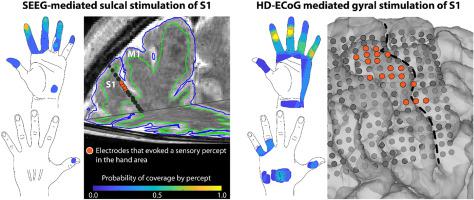Brain Stimulation ( IF 7.7 ) Pub Date : 2021-08-03 , DOI: 10.1016/j.brs.2021.07.009 Santosh Chandrasekaran 1 , Stephan Bickel 2 , Jose L Herrero 3 , Joo-Won Kim 4 , Noah Markowitz 5 , Elizabeth Espinal 5 , Nikunj A Bhagat 1 , Richard Ramdeo 1 , Junqian Xu 4 , Matthew F Glasser 6 , Chad E Bouton 7 , Ashesh D Mehta 3

|
Background
Paralysis and neuropathy, affecting millions of people worldwide, can be accompanied by significant loss of somatosensation. With tactile sensation being central to achieving dexterous movement, brain-computer interface (BCI) researchers have used intracortical and cortical surface electrical stimulation to restore somatotopically-relevant sensation to the hand. However, these approaches are restricted to stimulating the gyral areas of the brain. Since representation of distal regions of the hand extends into the sulcal regions of human primary somatosensory cortex (S1), it has been challenging to evoke sensory percepts localized to the fingertips.
Objective/hypothesis
Targeted stimulation of sulcal regions of S1, using stereoelectroencephalography (SEEG) depth electrodes, can evoke focal sensory percepts in the fingertips.
Methods
Two participants with intractable epilepsy received cortical stimulation both at the gyri via high-density electrocorticography (HD-ECoG) grids and in the sulci via SEEG depth electrode leads. We characterized the evoked sensory percepts localized to the hand.
Results
We show that highly focal percepts can be evoked in the fingertips of the hand through sulcal stimulation. fMRI, myelin content, and cortical thickness maps from the Human Connectome Project elucidated specific cortical areas and sub-regions within S1 that evoked these focal percepts. Within-participant comparisons showed that percepts evoked by sulcal stimulation via SEEG electrodes were significantly more focal (80% less area; p = 0.02) and localized to the fingertips more often, than by gyral stimulation via HD-ECoG electrodes. Finally, sulcal locations with consistent modulation of high-frequency neural activity during mechanical tactile stimulation of the fingertips showed the same somatotopic correspondence as cortical stimulation.
Conclusions
Our findings indicate minimally invasive sulcal stimulation via SEEG electrodes could be a clinically viable approach to restoring sensation.
中文翻译:

通过有针对性地刺激大脑的脑沟区域来唤起指尖的高度焦点感知以进行感觉恢复
背景
瘫痪和神经病变影响着全世界数百万人,可能伴随着体感的显着丧失。由于触觉是实现灵巧运动的核心,脑机接口 (BCI) 研究人员使用皮层内和皮层表面电刺激来恢复手部与躯体相关的感觉。然而,这些方法仅限于刺激大脑的回旋区域。由于手部远端区域的表示延伸到人类初级体感皮层 (S1) 的脑沟区域,因此唤起定位于指尖的感觉感知一直具有挑战性。
目标/假设
使用立体脑电图 (SEEG) 深度电极对 S1 的脑沟区域进行有针对性的刺激,可以唤起指尖的局灶性感觉。
方法
两名患有顽固性癫痫的参与者通过高密度皮层电图 (HD-ECoG) 网格在脑回和通过 SEEG 深度电极引线在脑沟接受皮层刺激。我们描述了定位于手部的诱发感官知觉。
结果
我们表明,通过脑沟刺激可以在手的指尖唤起高度焦点的感知。来自人类连接组计划的 fMRI、髓鞘含量和皮质厚度图阐明了 S1 内引起这些焦点感知的特定皮质区域和子区域。参与者内部比较表明,与通过 HD-ECoG 电极进行的脑回刺激相比,通过 SEEG 电极进行的脑沟刺激引起的感知明显更集中(面积减少 80%;p = 0.02),并且更频繁地定位于指尖。最后,在指尖的机械触觉刺激期间具有一致调制高频神经活动的脑沟位置显示出与皮层刺激相同的体细胞对应。
结论
我们的研究结果表明,通过 SEEG 电极进行的微创脑沟刺激可能是一种临床上可行的恢复感觉的方法。



























 京公网安备 11010802027423号
京公网安备 11010802027423号